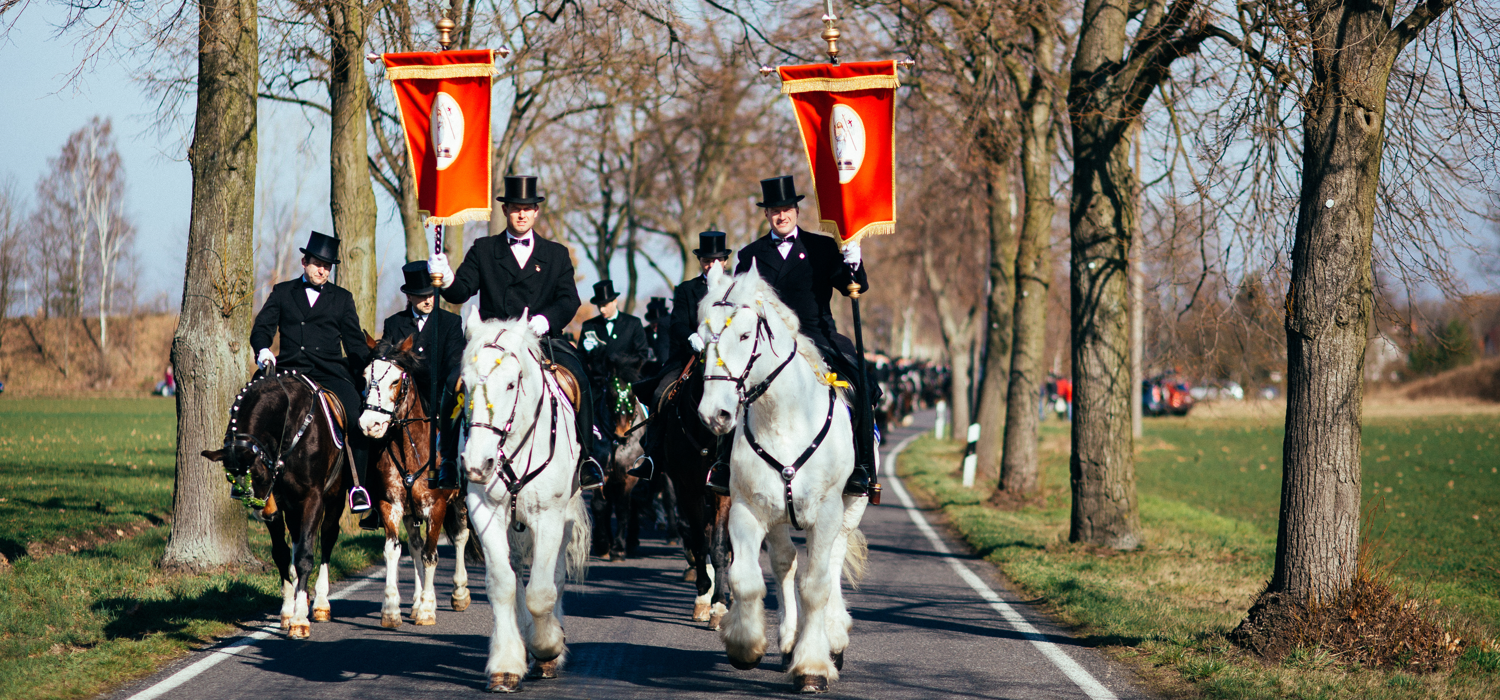
The ritual has been practiced for centuries, especially in the region between Hoyerswerda (Wojerecy), Kamenz (Kamjenc) and Bautzen (Budyšin). For many, especially the Catholic Church, the solemn procession is the highlight of Easter. The processions begin with a joint Easter service and the parade around the local church and cemetery three times, followed by a blessing by the priest. Then the bells ring and the Easter riders set off to bring the Easter message to the neighboring parishes in the form of traditional hymns in Sorbian and Latin. The church and the village square of each village through which the procession passes are also ridden around. Shortly before the ride and and sometimes between the villages, the rosary is usually prayed aloud. At the destination, the local priest welcomes the Easter riders and they are fed by the parish. Before they start the ride back, they pray together in front of the church and/or the cemetery. the cemetery. They are again blessed by the priest. The often richly decorated horses are carefully prepared on Holy Saturday. Young men aged 14 and over who are taking part for the first time wear a green wreath on their chest, while experienced riders wear a silver wreath for their 25th participation and a gold wreath for 50 years. Women take part in the preparation and follow-up of the parade. The Easter ride has been a historical tradition since the 15th century. Back then, the first equestrian processions took place between Hoyerswerda and Wittichenau. Despite a low point in the 1970s, when only 487 riders took part, the tradition has recovered and now has over 1500 participants again. There are currently four pairs of processions and one procession without a return visit in Upper Lusatia. The routes lead through numerous villages in Upper Lusatia, whereby the processions are planned in such a way that they do not cross each other. Particularly noteworthy is the procession from the town of Wittichenau, in which non-Sorbian riders also take part.
Quellenverzeichnis:
Katholisch.de (2015). Osterreiten bei den Sorben – Hoch zu Ross. Katholisch.de (2022). Sorbische Osterreiter wieder unterwegs in der Oberlausitz. MDR. (2025). Osterreiter: Was es mit der Tradition auf sich hat und wo sie zu sehen sind.Sachsen.de Osterreiten. Sorben.de (2025). Die Osterreiter. Sorbischerleben.de (2021). Osterreiten. Wikipedia. (2024). Osterreiten in Wikipedia.
Picture sponsorship
KRABAT region (KRABAT e.V.) - Discover and enjoy the legendary KRABAT region
Hardly any other legendary figure fascinates as many people as the Sorbian sorcerer KRABAT, who even gives his name to an entire region. The KRABAT region is located between Hoyerswerda (Wojerecy), Kamenz (Kamjenc) and Bautzen (Budyšin) in Upper Lusatia in the east of Saxony. What also makes the KRABAT region so unique is that the legendary figure of KRABAT can be proven historically. For example, thanks to years of research by Hans- Jürgen Schröter, a genealogist from WiNchenau, it has been proven that there is a connection between the Croatian colonel Johann von Schadowitz (hr: Janko Šajatović, 1624-1704) and the mysLc good sorcerer KRABAT. This gave rise to the first two KRABATschadowitz Experience Tours in Hoyerswerda (Wojerecy) and WiNchenau (Kulow). You can experience the KRABAT region primarily on the approx. 91 km long KRABAT cycle path, which connects the most important locations of the saga and also provides information about the history with the help of the cycle path boards at the respective staLons, e.g. at our partners in the KRABAT mill in Schwarzkollm (Čorny Chołmc), in the KRABAT milk world in Koeen (Koćina) and at the KRABAT farm in Eutrich (Jitk). A special highlight is the KRABAT week, which has been taking place since 2022, this year from 03.10 to 12.10. Here you can enjoy pure indulgence, as it is all about regional and seasonal offers along the KRABAT cycle path. So let yourself be enchanted by this unique region with all its treasures. Since its foundation in 2001, the association “Auf den Spuren des KRABAT- Verein zur regionalen Entwicklung in der zweisprachigen Lausitz e.V.” (in short: KRABAT e. V.) has been committed to the preservation of tradition, the passing on of customs and the revitalization of the Sorbian language as well as the promotion of sustainable tourism and regional economic cycles. Numerous projects have been conceived, planned and realized in the almost 25 years of the association's history, e.g. the KRABAT playground in Kamenz (Kamjenc), the KRABAT children's exhibition or the KRABAT festivals. The international sculpture days held in August at the KRABAT stone in Miltz (Miłoćicy), which have achieved supraregional radiance in the artistic field, are also part of this, as is the iniLator of KRABAT's new outbuilding in Groß Särchen (Wulke Zdźary), where the good spirit of KRABAT can be felt. It is currently being used by ZARI for the language project Domoj - intensive Sorbian learning in 9 months.

































